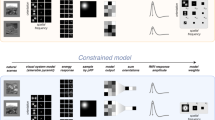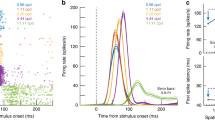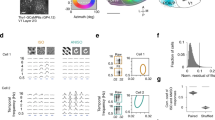Abstract
Although cortical neurons with similar functional properties often cluster together in a columnar organization, only ocular dominance columns, the columnar structure representing segregated anatomical input (from one of the two eyes), have been found in human primary visual cortex (V1). It has yet to be shown whether other columnar organizations that arise only from differential responses to stimulus properties also exist in human V1. Using high-resolution functional magnetic resonance imaging, we have found such a functional architecture containing domains that respond preferentially to either low or high temporal frequency.


Similar content being viewed by others
References
Shoham, D., Hubener, M., Schulze, S., Grinvald, A. & Bonhoeffer, T. Nature 385, 529–533 (1997).
DeAngelis, G.C., Ghose, G.M., Ohzawa, I. & Freeman, R.D.J. J. Neurosci. 19, 4046–4064 (1999).
Hammett, S.T. & Smith, A.T. Vision Res. 32, 285–291 (1992).
Baker, T.I. & Issa, N.P. J. Neurophysiol. 94, 775–787 (2005).
Basole, A., White, L.E. & Fitzpatrick, D. Nature 423, 986–990 (2003).
Horton, J.C., Dagi, L.R., McCrane, E.P. & de Monasterio, F.M. Arch. Ophthalmol. 108, 1025–1031 (1990).
Cheng, K., Waggoner, R.A. & Tanaka, K. Neuron 32, 359–374 (2001).
Shmuel, A., Yacoub, E., Chaimow, D., Logothetis, N.K. & Ugurbil, K. Neuroimage 35, 539–552 (2007).
Grinvald, A., Slovin, H. & Vanzetta, I. Nat. Neurosci. 3, 105–107 (2000).
Hawken, M.J., Shapley, R.M. & Grosof, D.H. Vis. Neurosci. 13, 477–492 (1996).
Foster, K.H., Gaska, J.P., Nagler, M. & Pollen, D.A.J. J. Physiol. 365, 331–363 (1985).
Rojer, A.S. & Schwartz, E.L. Biol. Cybern. 62, 381–391 (1990).
Carandini, M. & Sengpiel, F. J. Vis. 4, 130–143 (2004).
Tootell, R.B., Hamilton, S.L. & Switkes, E. J. Neurosci. 8, 1594–1609 (1988).
Van Essen, D.C. & Gallant, J.L. Neuron 13, 1–10 (1994).
Acknowledgements
We are indebted to our subjects for their time and efforts participating in the experiment. P.S. and J.L.G. were supported in part by postdoctoral fellowships from the Japan Society for the Promotion of Science.
Author information
Authors and Affiliations
Corresponding author
Supplementary information
Supplementary Text and Figures
Supplementary Figures 1–10 Table 1 and Methods (PDF 1975 kb)
Rights and permissions
About this article
Cite this article
Sun, P., Ueno, K., Waggoner, R. et al. A temporal frequency–dependent functional architecture in human V1 revealed by high-resolution fMRI. Nat Neurosci 10, 1404–1406 (2007). https://doi.org/10.1038/nn1983
Received:
Accepted:
Published:
Issue Date:
DOI: https://doi.org/10.1038/nn1983
- Springer Nature America, Inc.
This article is cited by
-
Natural scene sampling reveals reliable coarse-scale orientation tuning in human V1
Nature Communications (2022)
-
Frequency-specific altered global signal topography in drug-naïve first-episode patients with adolescent-onset schizophrenia
Brain Imaging and Behavior (2021)
-
Interaction between steady-state visually evoked potentials at nearby flicker frequencies
Scientific Reports (2020)
-
In vivo evidence of functional and anatomical stripe-based subdivisions in human V2 and V3
Scientific Reports (2017)
-
A proof-of-concept study for developing integrated two-photon microscopic and magnetic resonance imaging modality at ultrahigh field of 16.4 tesla
Scientific Reports (2017)





